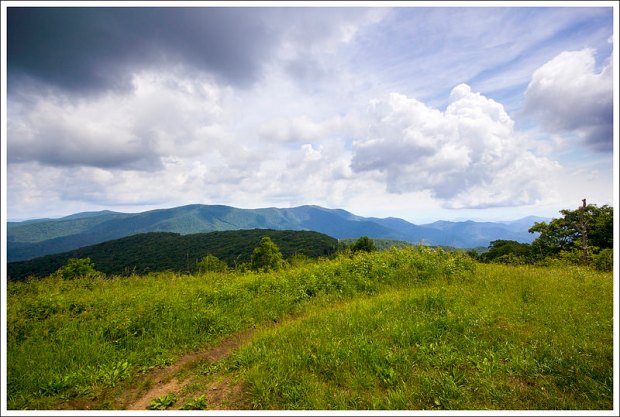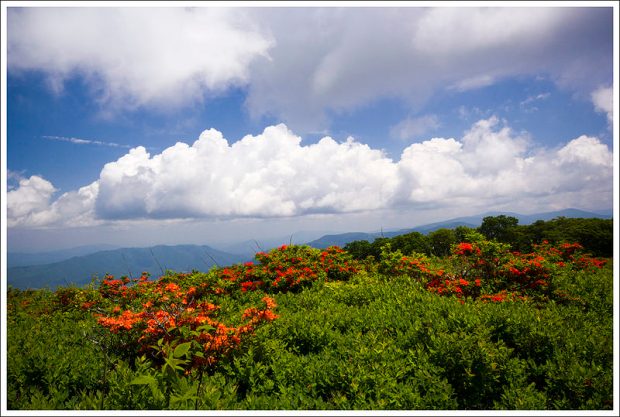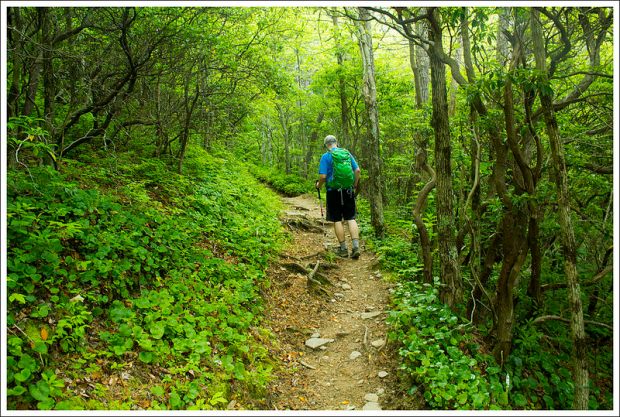Introductory Guide to Visiting Great Smoky Mountains National Park Area
Hiking from Wayah Gap to Wayah Bald is a fun, moderate 8.5 mile hike. The view from a top the stone observation tower has to be among the best in the area.
View the Full Album of Photos From This Hike
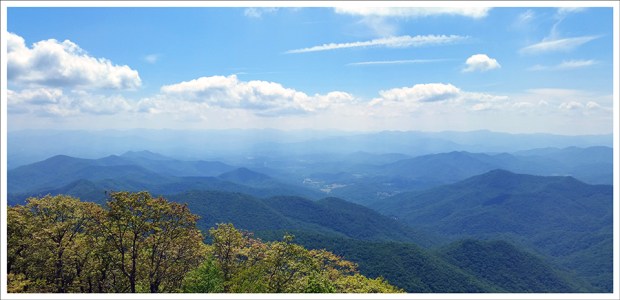
Adam Says…
This hike was a true gem! When you are just reading text about a hike, you can’t get a great idea of how wonderful a hike will be (hopefully this write-up and pictures will help). What we couldn’t believe through the day was how uncrowded this trail was, especially at the fire tower. We went on a perfect weekend day and you can even drive up to the very top if you want to skip the hike but still get the views. Having a spot like this to yourself just doesn’t seem right.
“Wayah” comes from the Cherokee word for “wolf”, since red wolves were once part of this area. The tower was built in 1937 by the Civilian Conservation Corps and used as a lookout for fires in the area.
As we were driving on Wayah Road making our way to the top, we were both thankful that the drive up would take a lot of feet off the elevation. The road winds around the mountain as it is taking many switchbacks to get up to the top. At the crest was the sign for the Wayah Bald Fire Tower and a small parking lot to the side. We started on the white-blazed Appalachian Trail going north (the same side as the sign and the parking lot). You climb up a few water-bar stairs and then come to a sign for Wayah Gap. The trail runs parallel to a national forest road on the left for the first portion of the trail (this is the same forest road you can drive to get to the top without hiking).

The trail was filled with wildflowers and greenery everywhere you looked and overall the uphill climb was quite manageable. At 1.75 miles, you make a steeper climb up to a forest road (the same forest road leading to the top). The trail picks up on the other side, but there is a spring to the right of the trail if you need to refill water. Crossing the road, you head up some stairs and up a steeper section looking down on the fire road, before it resumes the gradual climb.
At 2.15 and 2.35 miles, you will see junctions with the yellow-blazed Bartram Trail (a 110 mile trail that goes from Northern Georgia into Southwest North Carolina) and a forest road on the left side. This trail loops around for an extra 5.4 miles, but stay on the main white-blazed Appalachian Trail. Since the Bartram Trail joins the AT through this section, you will often see yellow and white blazes together. At 2.5 miles the trail levels out and then starts to descend.

Descending through the forest, the trail then begins to skirt along the mountainside. The trail became narrow and overgrown as you walk through some high grass and brush. But, you do get some more open, yet obstructed views of the valley between the mountains. At 3.5 miles, the trail reaches its bottom and then begins to ascend again. At 3.8 miles, you cross the forest road again and at 4.15 miles, you reach the final junction with the paved forest road. Going to the right leads to a picnic area with nice views (and a bathroom if you need it). Heading to the left from the junction, leads to the Wayah Bald fire tower which we reached around 4.3 miles.
The views from the fire tower were amazing! Some fire towers are rickety and you wonder if all the bolts have been screwed and tightened in the last few decades. This structure was a nice stone fire tower with a few steps to the top. From the top of the tower are maps that will help you identify the mountains in the ranges around you. If you go on a clear day, you should be able to see for quite a distance.
We stayed at the top for quite a while and this was definitely my top hike from this trip. We ate our packed lunch and talked to the few people we saw at the top, but it was hard to pull me away from the stunning landscape around me. If you aren’t capable of doing the hike, this is still a place to visit on a trip in North Carolina.
Christine Says…
This was another hike I mapped out using my AWOL Guide for the Appalachian Trail. You can practically drive up to the tower, but we wanted to put in longer trail miles, so we opted to start at Wayah Gap, about four miles south of Wayah Bald.
It turned out to be a beautiful hike! There were tons of blooming wildflowers, a crisp breeze, abundant sunshine, and pleasant temperatures. I was thrilled to see the last few red trillium blooms and the first of the flame azaleas lighting up the forest. The hike was perfectly timed to see lots of wildflowers.
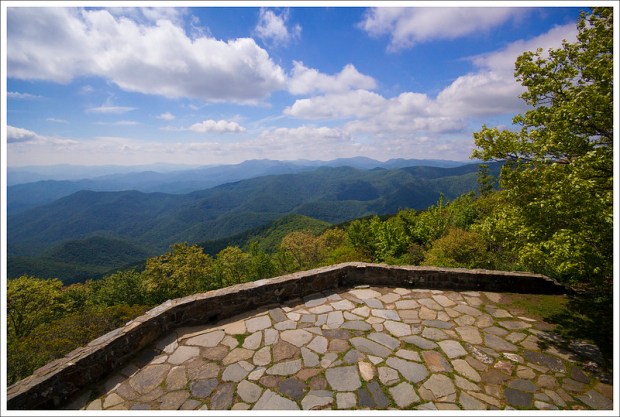
We started early and had most of the trail to ourselves. Just a few tenths of a mile after starting, we passed a very early-season southbound thru-hiker. I didn’t know it at the time, but we learned later that he was Mountain Man – possibly the oldest person to ever complete a winter thru-hike. He finished about ten days after our paths crossed.
The terrain on the way to Wayah Bald was pretty gentle – moderate climbs and descents and lots of easy walking. We passed several really nice campsites along the way, with the largest and nicest being located at the junction of the AT and the Bartram Trail.
We walked through an area that was recently burned, leaving behind some open views and lots of fast-growing tall grass to wade through. Most of the sunny spots on the trail were pretty overgrown.
When we arrived at Wayah Bald, we took a wrong turn and ended up walking up to the picnic area. It was a lucky mistake, because the picnic area offers a second beautiful vista. Once we realized we were in the wrong place, we turned around an walked the opposite way up to the tower.

There were only three or four other people at the tower, despite it being a beautiful holiday weekend. We climbed to the top and ate a snack. We loved looking at and identifying the other mountains that made up the panoramic vista. One of the most recognizable was Siler Bald – identified by the wide grassy swath leading to the summit. We spent a bit more time enjoying the spectacular view before making our way back.
After the hike, we decided to go to one of our favorite places – the Nantahala Outdoor Center. The place was hopping with Memorial Day activities, but we were still able to find a parking spot and a table at Big Wesser Brew & BBQ.
Trail Notes
- Distance – 8.5 miles
(Check out the stats from Map My Hike)* - Elevation Change – 1613 ft.
- Difficulty – 3. The length makes this rated a 3, but the overall climb was manageable.
- Trail Conditions – 3. The trail was well-maintained, but very overgrown from the junction with the Bartram Trail leading up to the summit. There weren’t many rocky sections, so it made for nice footing most of the trail.
- Views – 5. Panoramic, 360-degree views from the Fire Tower on a clear day.
- Streams/Waterfalls – 1. There were two adequate springs to use as water sources along the way.
- Wildlife – 2. Nothing spotted on this trail.
- Ease to Navigate – 4.0. As long as you follow the white blazes for the Appalachian Trail, you should be in good shape.
- Solitude – 4. Maybe we hit this on an odd day, but we had a lot of solitude on a “should have been busy” day and even had the fire tower to ourselves for about 15 minutes.
Download a Trail Map (PDF)
Directions to trailhead: GPS coordinates for this trailhead are 35.153662, -83.580462. From Highway 74 in North Carolina (near Cherokee/Bryson City) take the US23 S/US 441 S exit for Dillsboro/Franklin/Atlanta. Follow this road for 20.4 miles to the junction with US64 W. Follow 64W for 3.7 miles. Take a right on Patton Road. Follow Patton for .3 of a mile and then turn left on Wayah Road. Follow Wayah Road for 9 miles until you reach the well-marked trail crossing. Follow the Appalachian Trail north from this point.




















































